Sustainable Tourism Development – Doc
VerifiedAdded on 2021/02/19
|13
|4079
|84
AI Summary
Contribute Materials
Your contribution can guide someone’s learning journey. Share your
documents today.
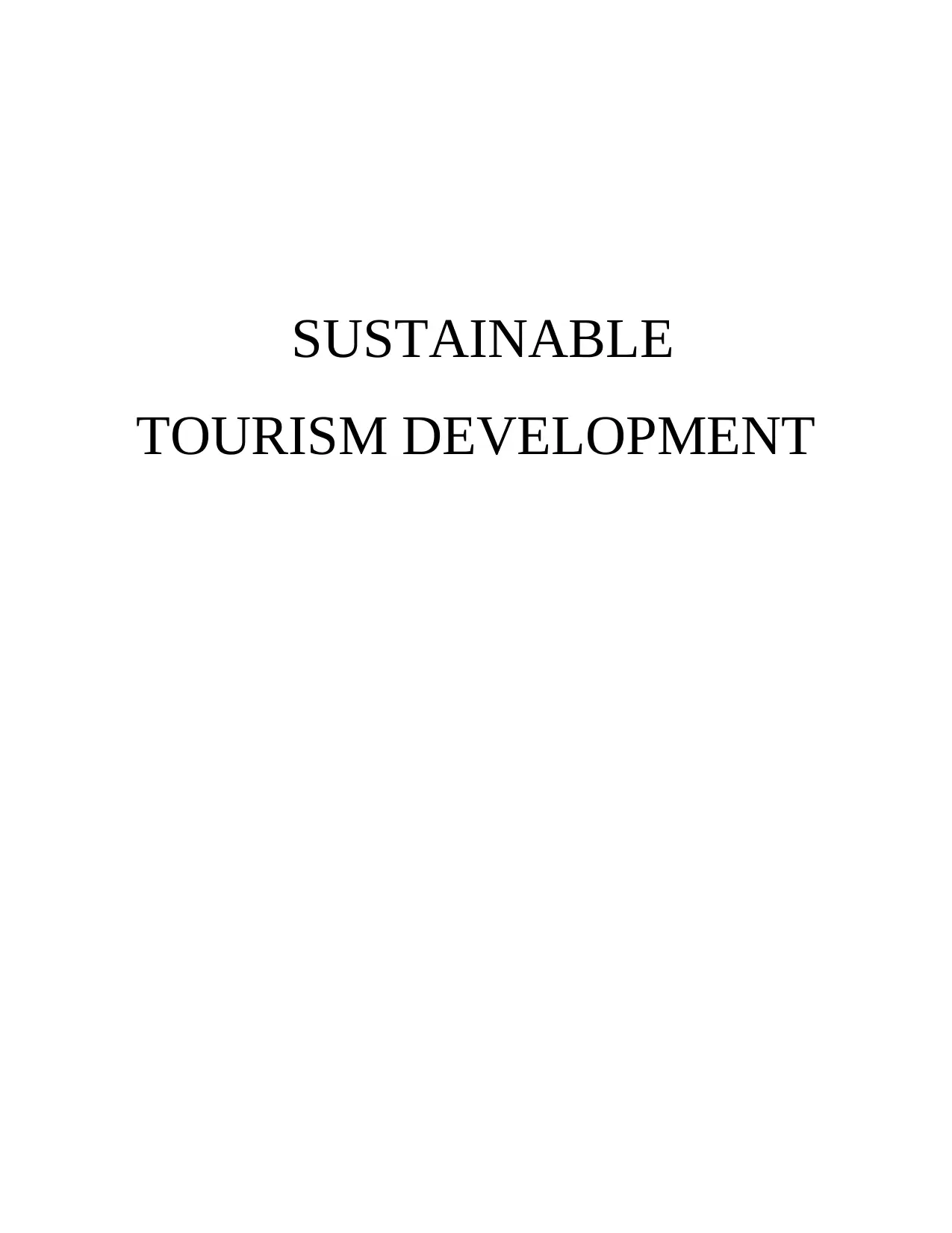
SUSTAINABLE
TOURISM DEVELOPMENT
TOURISM DEVELOPMENT
Secure Best Marks with AI Grader
Need help grading? Try our AI Grader for instant feedback on your assignments.
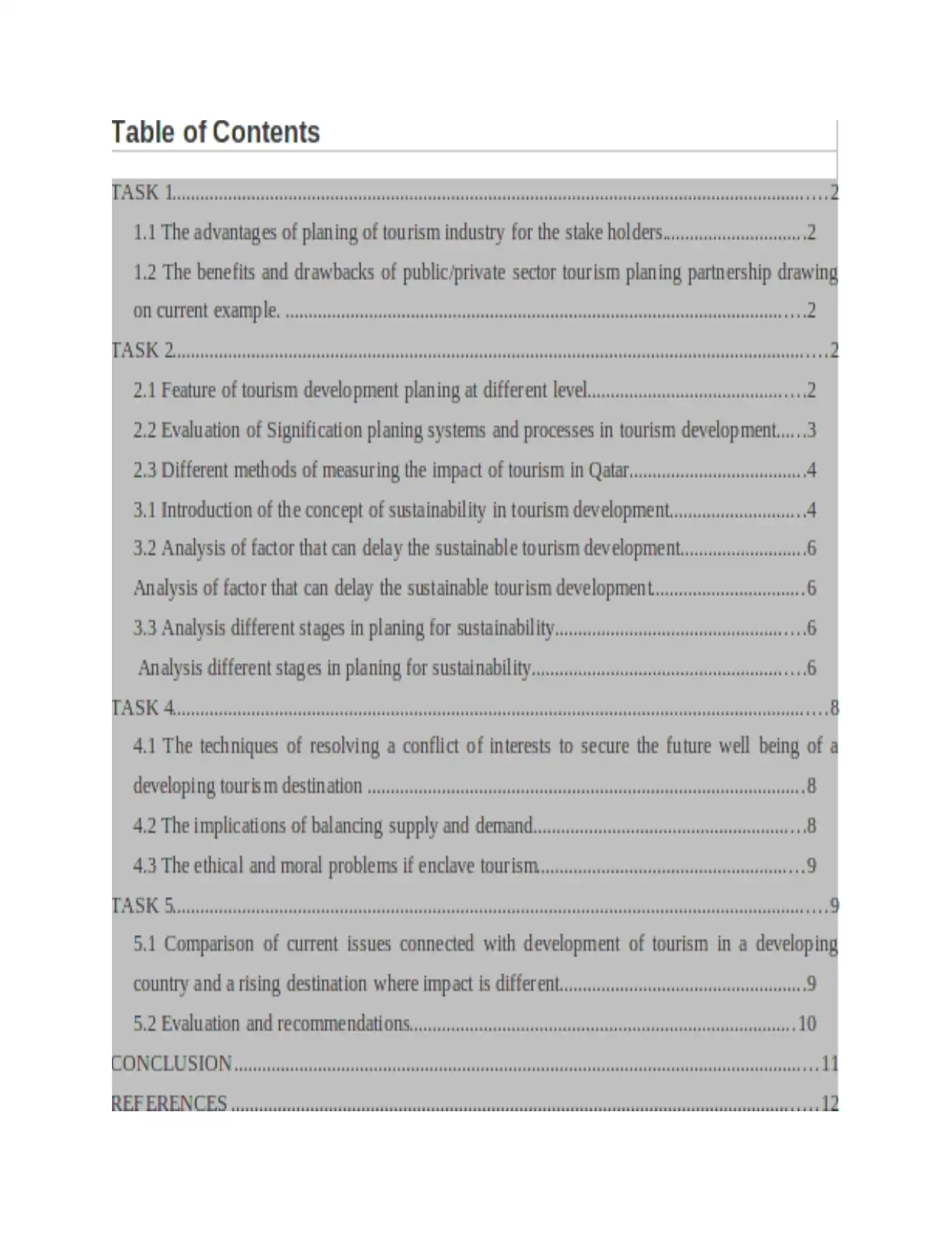
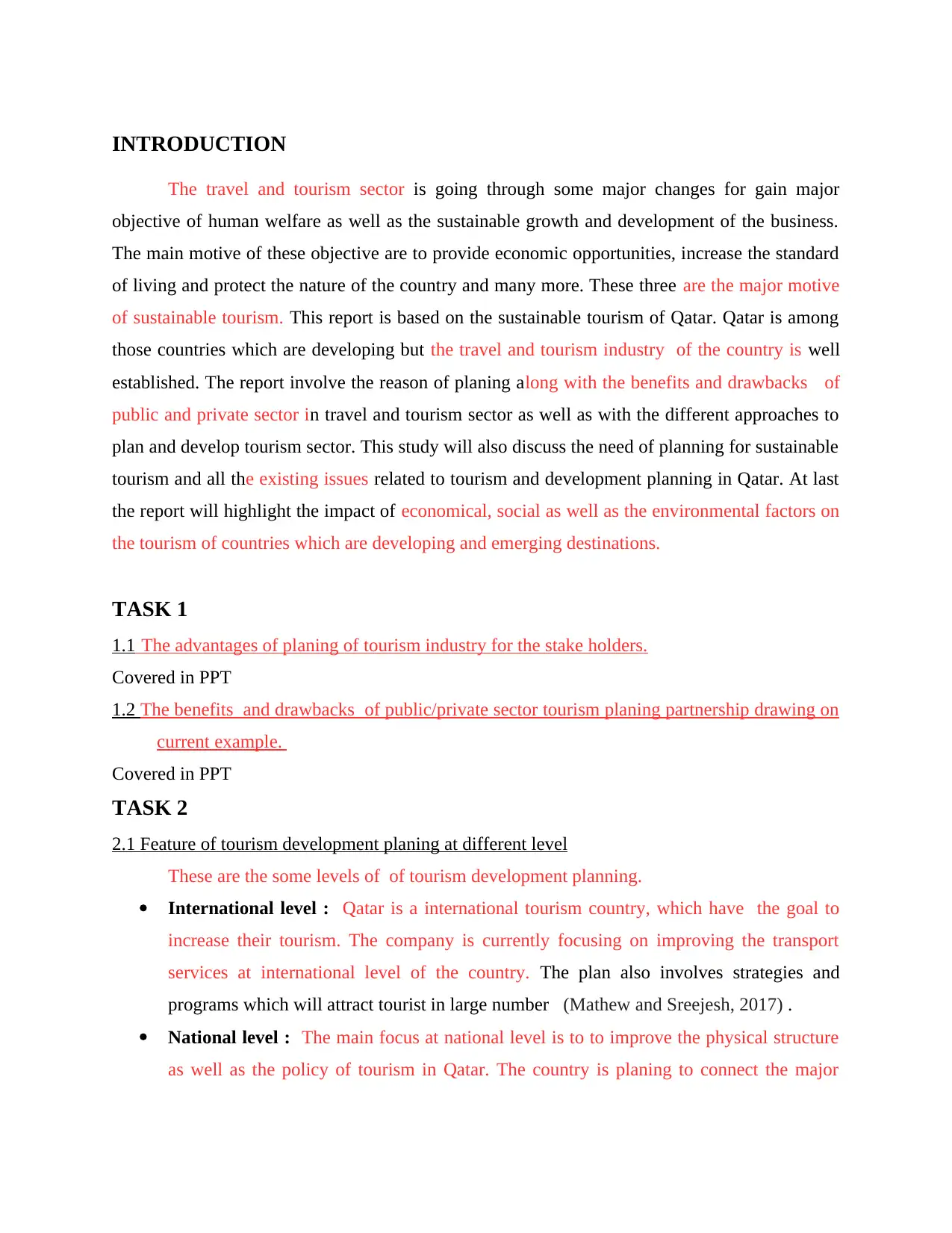
INTRODUCTION
The travel and tourism sector is going through some major changes for gain major
objective of human welfare as well as the sustainable growth and development of the business.
The main motive of these objective are to provide economic opportunities, increase the standard
of living and protect the nature of the country and many more. These three are the major motive
of sustainable tourism. This report is based on the sustainable tourism of Qatar. Qatar is among
those countries which are developing but the travel and tourism industry of the country is well
established. The report involve the reason of planing along with the benefits and drawbacks of
public and private sector in travel and tourism sector as well as with the different approaches to
plan and develop tourism sector. This study will also discuss the need of planning for sustainable
tourism and all the existing issues related to tourism and development planning in Qatar. At last
the report will highlight the impact of economical, social as well as the environmental factors on
the tourism of countries which are developing and emerging destinations.
TASK 1
1.1 The advantages of planing of tourism industry for the stake holders.
Covered in PPT
1.2 The benefits and drawbacks of public/private sector tourism planing partnership drawing on
current example.
Covered in PPT
TASK 2
2.1 Feature of tourism development planing at different level
These are the some levels of of tourism development planning.
International level : Qatar is a international tourism country, which have the goal to
increase their tourism. The company is currently focusing on improving the transport
services at international level of the country. The plan also involves strategies and
programs which will attract tourist in large number (Mathew and Sreejesh, 2017) .
National level : The main focus at national level is to to improve the physical structure
as well as the policy of tourism in Qatar. The country is planing to connect the major
The travel and tourism sector is going through some major changes for gain major
objective of human welfare as well as the sustainable growth and development of the business.
The main motive of these objective are to provide economic opportunities, increase the standard
of living and protect the nature of the country and many more. These three are the major motive
of sustainable tourism. This report is based on the sustainable tourism of Qatar. Qatar is among
those countries which are developing but the travel and tourism industry of the country is well
established. The report involve the reason of planing along with the benefits and drawbacks of
public and private sector in travel and tourism sector as well as with the different approaches to
plan and develop tourism sector. This study will also discuss the need of planning for sustainable
tourism and all the existing issues related to tourism and development planning in Qatar. At last
the report will highlight the impact of economical, social as well as the environmental factors on
the tourism of countries which are developing and emerging destinations.
TASK 1
1.1 The advantages of planing of tourism industry for the stake holders.
Covered in PPT
1.2 The benefits and drawbacks of public/private sector tourism planing partnership drawing on
current example.
Covered in PPT
TASK 2
2.1 Feature of tourism development planing at different level
These are the some levels of of tourism development planning.
International level : Qatar is a international tourism country, which have the goal to
increase their tourism. The company is currently focusing on improving the transport
services at international level of the country. The plan also involves strategies and
programs which will attract tourist in large number (Mathew and Sreejesh, 2017) .
National level : The main focus at national level is to to improve the physical structure
as well as the policy of tourism in Qatar. The country is planing to connect the major
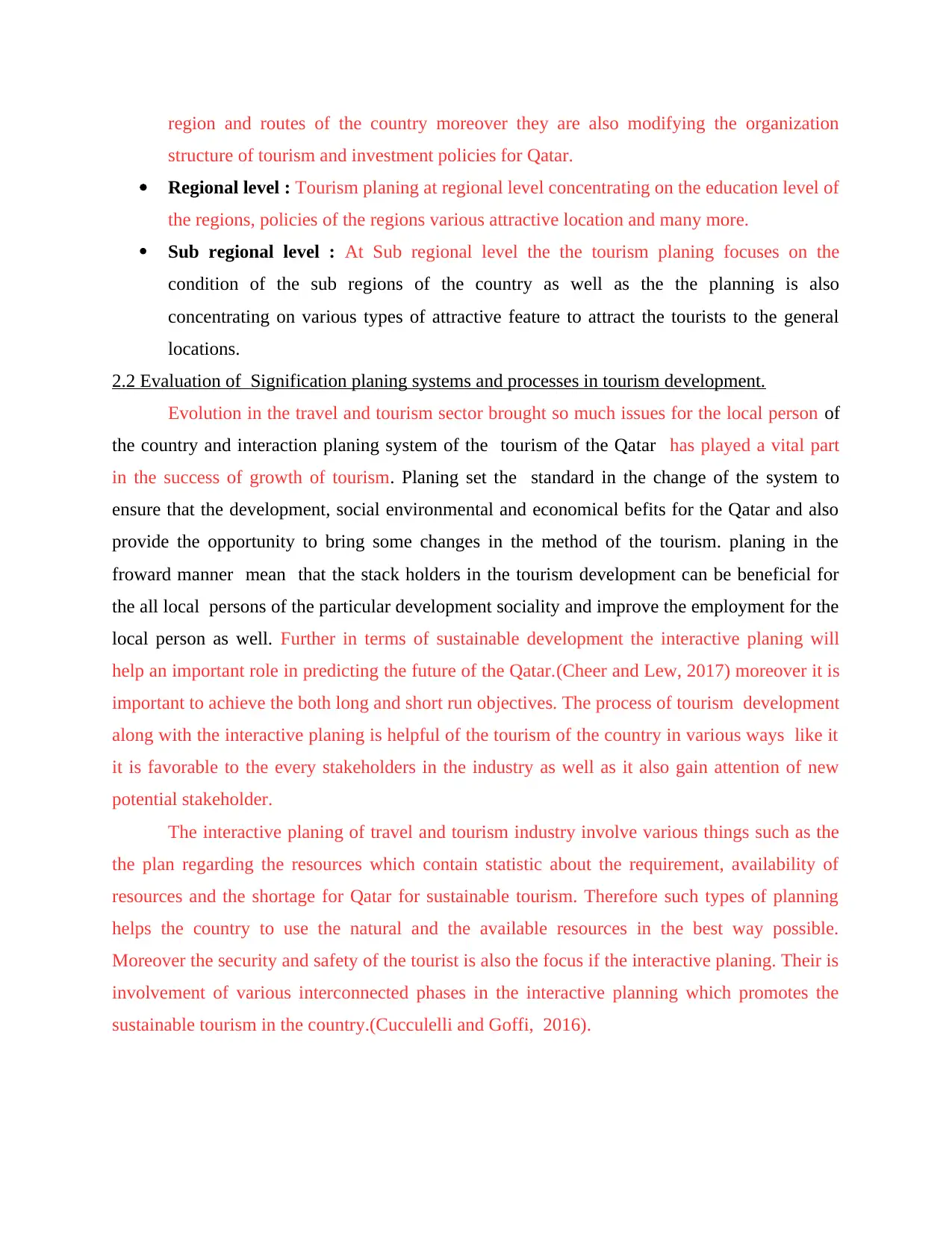
region and routes of the country moreover they are also modifying the organization
structure of tourism and investment policies for Qatar.
Regional level : Tourism planing at regional level concentrating on the education level of
the regions, policies of the regions various attractive location and many more.
Sub regional level : At Sub regional level the the tourism planing focuses on the
condition of the sub regions of the country as well as the the planning is also
concentrating on various types of attractive feature to attract the tourists to the general
locations.
2.2 Evaluation of Signification planing systems and processes in tourism development.
Evolution in the travel and tourism sector brought so much issues for the local person of
the country and interaction planing system of the tourism of the Qatar has played a vital part
in the success of growth of tourism. Planing set the standard in the change of the system to
ensure that the development, social environmental and economical befits for the Qatar and also
provide the opportunity to bring some changes in the method of the tourism. planing in the
froward manner mean that the stack holders in the tourism development can be beneficial for
the all local persons of the particular development sociality and improve the employment for the
local person as well. Further in terms of sustainable development the interactive planing will
help an important role in predicting the future of the Qatar.(Cheer and Lew, 2017) moreover it is
important to achieve the both long and short run objectives. The process of tourism development
along with the interactive planing is helpful of the tourism of the country in various ways like it
it is favorable to the every stakeholders in the industry as well as it also gain attention of new
potential stakeholder.
The interactive planing of travel and tourism industry involve various things such as the
the plan regarding the resources which contain statistic about the requirement, availability of
resources and the shortage for Qatar for sustainable tourism. Therefore such types of planning
helps the country to use the natural and the available resources in the best way possible.
Moreover the security and safety of the tourist is also the focus if the interactive planing. Their is
involvement of various interconnected phases in the interactive planning which promotes the
sustainable tourism in the country.(Cucculelli and Goffi, 2016).
structure of tourism and investment policies for Qatar.
Regional level : Tourism planing at regional level concentrating on the education level of
the regions, policies of the regions various attractive location and many more.
Sub regional level : At Sub regional level the the tourism planing focuses on the
condition of the sub regions of the country as well as the the planning is also
concentrating on various types of attractive feature to attract the tourists to the general
locations.
2.2 Evaluation of Signification planing systems and processes in tourism development.
Evolution in the travel and tourism sector brought so much issues for the local person of
the country and interaction planing system of the tourism of the Qatar has played a vital part
in the success of growth of tourism. Planing set the standard in the change of the system to
ensure that the development, social environmental and economical befits for the Qatar and also
provide the opportunity to bring some changes in the method of the tourism. planing in the
froward manner mean that the stack holders in the tourism development can be beneficial for
the all local persons of the particular development sociality and improve the employment for the
local person as well. Further in terms of sustainable development the interactive planing will
help an important role in predicting the future of the Qatar.(Cheer and Lew, 2017) moreover it is
important to achieve the both long and short run objectives. The process of tourism development
along with the interactive planing is helpful of the tourism of the country in various ways like it
it is favorable to the every stakeholders in the industry as well as it also gain attention of new
potential stakeholder.
The interactive planing of travel and tourism industry involve various things such as the
the plan regarding the resources which contain statistic about the requirement, availability of
resources and the shortage for Qatar for sustainable tourism. Therefore such types of planning
helps the country to use the natural and the available resources in the best way possible.
Moreover the security and safety of the tourist is also the focus if the interactive planing. Their is
involvement of various interconnected phases in the interactive planning which promotes the
sustainable tourism in the country.(Cucculelli and Goffi, 2016).
Secure Best Marks with AI Grader
Need help grading? Try our AI Grader for instant feedback on your assignments.
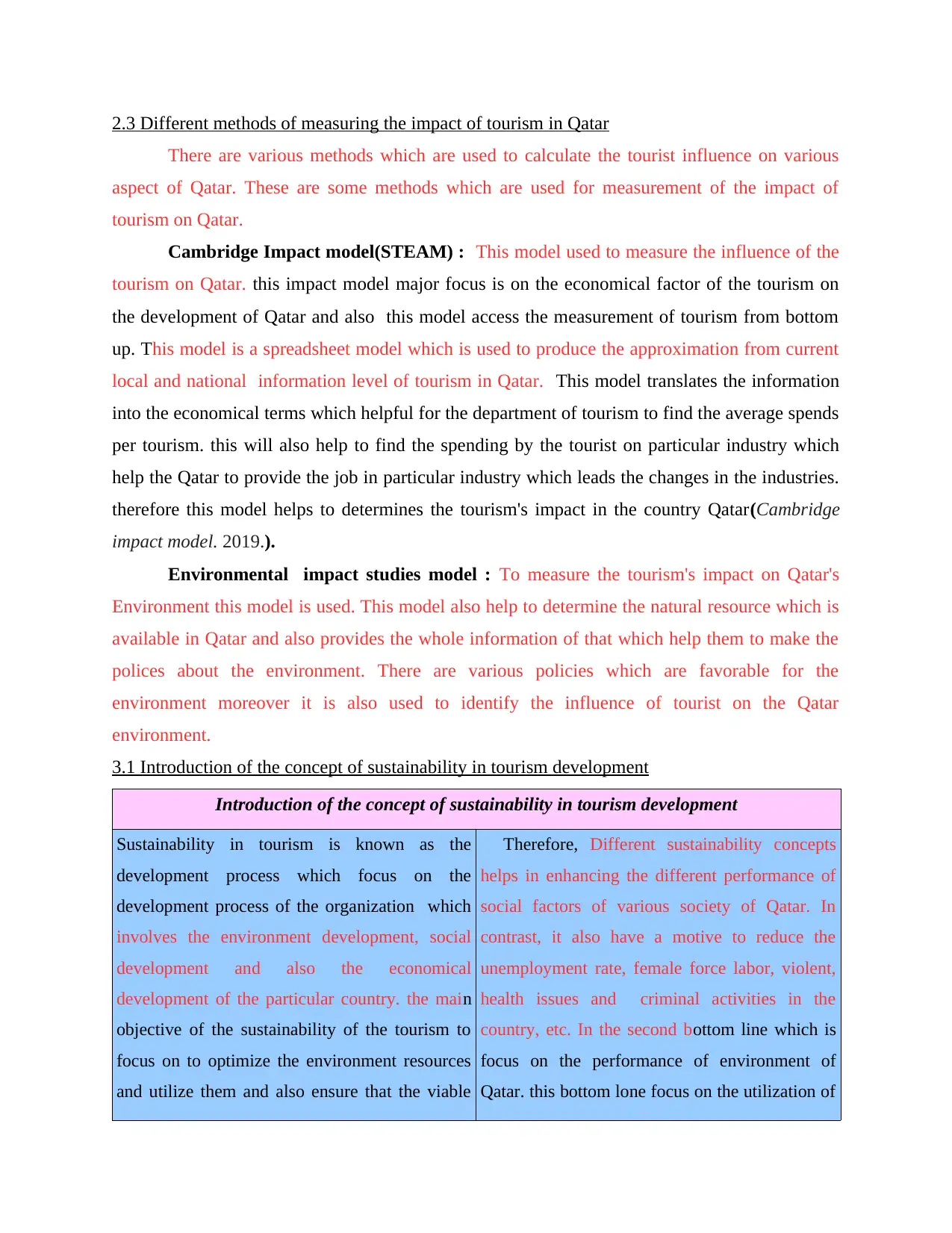
2.3 Different methods of measuring the impact of tourism in Qatar
There are various methods which are used to calculate the tourist influence on various
aspect of Qatar. These are some methods which are used for measurement of the impact of
tourism on Qatar.
Cambridge Impact model(STEAM) : This model used to measure the influence of the
tourism on Qatar. this impact model major focus is on the economical factor of the tourism on
the development of Qatar and also this model access the measurement of tourism from bottom
up. This model is a spreadsheet model which is used to produce the approximation from current
local and national information level of tourism in Qatar. This model translates the information
into the economical terms which helpful for the department of tourism to find the average spends
per tourism. this will also help to find the spending by the tourist on particular industry which
help the Qatar to provide the job in particular industry which leads the changes in the industries.
therefore this model helps to determines the tourism's impact in the country Qatar(Cambridge
impact model. 2019.).
Environmental impact studies model : To measure the tourism's impact on Qatar's
Environment this model is used. This model also help to determine the natural resource which is
available in Qatar and also provides the whole information of that which help them to make the
polices about the environment. There are various policies which are favorable for the
environment moreover it is also used to identify the influence of tourist on the Qatar
environment.
3.1 Introduction of the concept of sustainability in tourism development
Introduction of the concept of sustainability in tourism development
Sustainability in tourism is known as the
development process which focus on the
development process of the organization which
involves the environment development, social
development and also the economical
development of the particular country. the main
objective of the sustainability of the tourism to
focus on to optimize the environment resources
and utilize them and also ensure that the viable
Therefore, Different sustainability concepts
helps in enhancing the different performance of
social factors of various society of Qatar. In
contrast, it also have a motive to reduce the
unemployment rate, female force labor, violent,
health issues and criminal activities in the
country, etc. In the second bottom line which is
focus on the performance of environment of
Qatar. this bottom lone focus on the utilization of
There are various methods which are used to calculate the tourist influence on various
aspect of Qatar. These are some methods which are used for measurement of the impact of
tourism on Qatar.
Cambridge Impact model(STEAM) : This model used to measure the influence of the
tourism on Qatar. this impact model major focus is on the economical factor of the tourism on
the development of Qatar and also this model access the measurement of tourism from bottom
up. This model is a spreadsheet model which is used to produce the approximation from current
local and national information level of tourism in Qatar. This model translates the information
into the economical terms which helpful for the department of tourism to find the average spends
per tourism. this will also help to find the spending by the tourist on particular industry which
help the Qatar to provide the job in particular industry which leads the changes in the industries.
therefore this model helps to determines the tourism's impact in the country Qatar(Cambridge
impact model. 2019.).
Environmental impact studies model : To measure the tourism's impact on Qatar's
Environment this model is used. This model also help to determine the natural resource which is
available in Qatar and also provides the whole information of that which help them to make the
polices about the environment. There are various policies which are favorable for the
environment moreover it is also used to identify the influence of tourist on the Qatar
environment.
3.1 Introduction of the concept of sustainability in tourism development
Introduction of the concept of sustainability in tourism development
Sustainability in tourism is known as the
development process which focus on the
development process of the organization which
involves the environment development, social
development and also the economical
development of the particular country. the main
objective of the sustainability of the tourism to
focus on to optimize the environment resources
and utilize them and also ensure that the viable
Therefore, Different sustainability concepts
helps in enhancing the different performance of
social factors of various society of Qatar. In
contrast, it also have a motive to reduce the
unemployment rate, female force labor, violent,
health issues and criminal activities in the
country, etc. In the second bottom line which is
focus on the performance of environment of
Qatar. this bottom lone focus on the utilization of
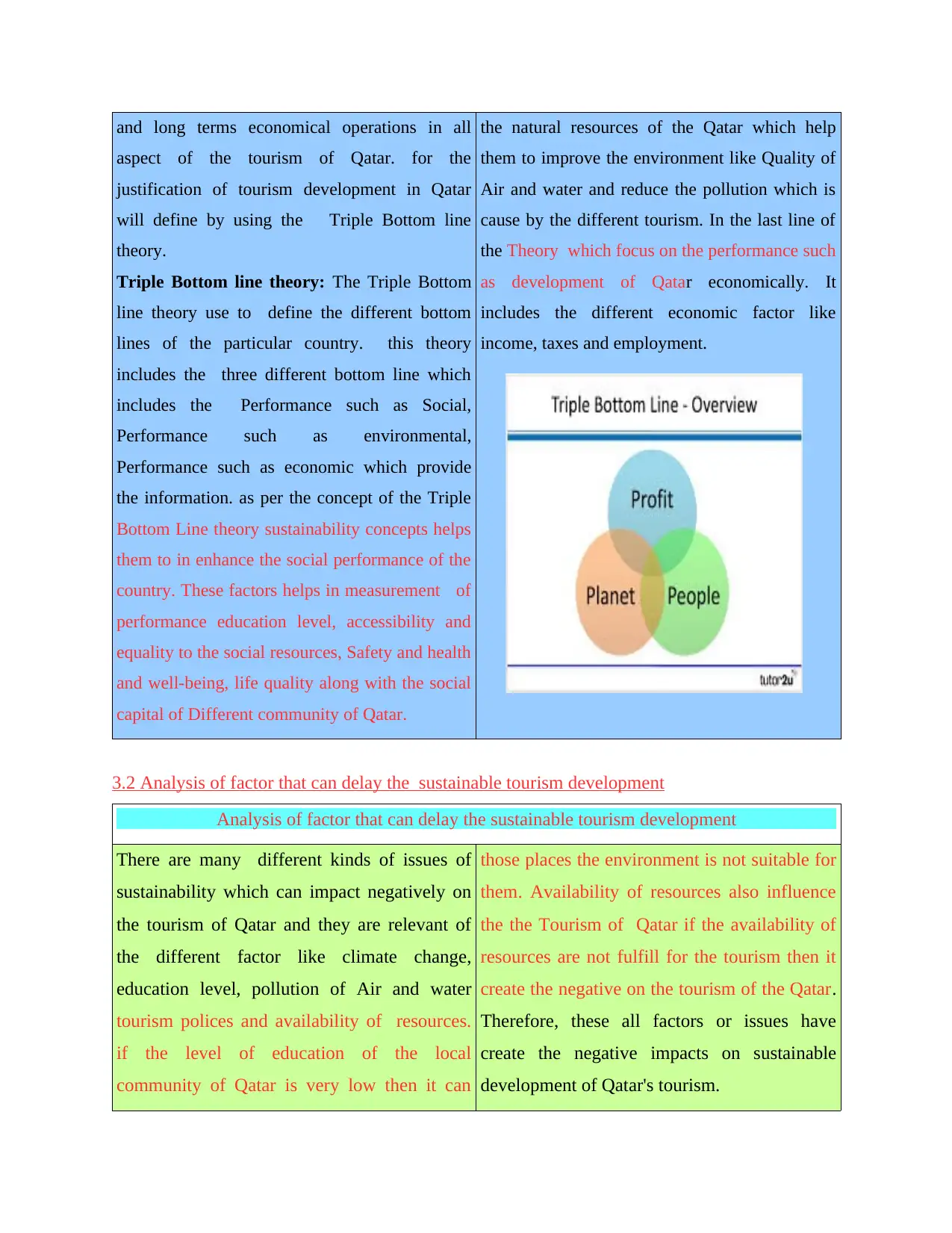
and long terms economical operations in all
aspect of the tourism of Qatar. for the
justification of tourism development in Qatar
will define by using the Triple Bottom line
theory.
Triple Bottom line theory: The Triple Bottom
line theory use to define the different bottom
lines of the particular country. this theory
includes the three different bottom line which
includes the Performance such as Social,
Performance such as environmental,
Performance such as economic which provide
the information. as per the concept of the Triple
Bottom Line theory sustainability concepts helps
them to in enhance the social performance of the
country. These factors helps in measurement of
performance education level, accessibility and
equality to the social resources, Safety and health
and well-being, life quality along with the social
capital of Different community of Qatar.
the natural resources of the Qatar which help
them to improve the environment like Quality of
Air and water and reduce the pollution which is
cause by the different tourism. In the last line of
the Theory which focus on the performance such
as development of Qatar economically. It
includes the different economic factor like
income, taxes and employment.
3.2 Analysis of factor that can delay the sustainable tourism development
Analysis of factor that can delay the sustainable tourism development
There are many different kinds of issues of
sustainability which can impact negatively on
the tourism of Qatar and they are relevant of
the different factor like climate change,
education level, pollution of Air and water
tourism polices and availability of resources.
if the level of education of the local
community of Qatar is very low then it can
those places the environment is not suitable for
them. Availability of resources also influence
the the Tourism of Qatar if the availability of
resources are not fulfill for the tourism then it
create the negative on the tourism of the Qatar.
Therefore, these all factors or issues have
create the negative impacts on sustainable
development of Qatar's tourism.
aspect of the tourism of Qatar. for the
justification of tourism development in Qatar
will define by using the Triple Bottom line
theory.
Triple Bottom line theory: The Triple Bottom
line theory use to define the different bottom
lines of the particular country. this theory
includes the three different bottom line which
includes the Performance such as Social,
Performance such as environmental,
Performance such as economic which provide
the information. as per the concept of the Triple
Bottom Line theory sustainability concepts helps
them to in enhance the social performance of the
country. These factors helps in measurement of
performance education level, accessibility and
equality to the social resources, Safety and health
and well-being, life quality along with the social
capital of Different community of Qatar.
the natural resources of the Qatar which help
them to improve the environment like Quality of
Air and water and reduce the pollution which is
cause by the different tourism. In the last line of
the Theory which focus on the performance such
as development of Qatar economically. It
includes the different economic factor like
income, taxes and employment.
3.2 Analysis of factor that can delay the sustainable tourism development
Analysis of factor that can delay the sustainable tourism development
There are many different kinds of issues of
sustainability which can impact negatively on
the tourism of Qatar and they are relevant of
the different factor like climate change,
education level, pollution of Air and water
tourism polices and availability of resources.
if the level of education of the local
community of Qatar is very low then it can
those places the environment is not suitable for
them. Availability of resources also influence
the the Tourism of Qatar if the availability of
resources are not fulfill for the tourism then it
create the negative on the tourism of the Qatar.
Therefore, these all factors or issues have
create the negative impacts on sustainable
development of Qatar's tourism.
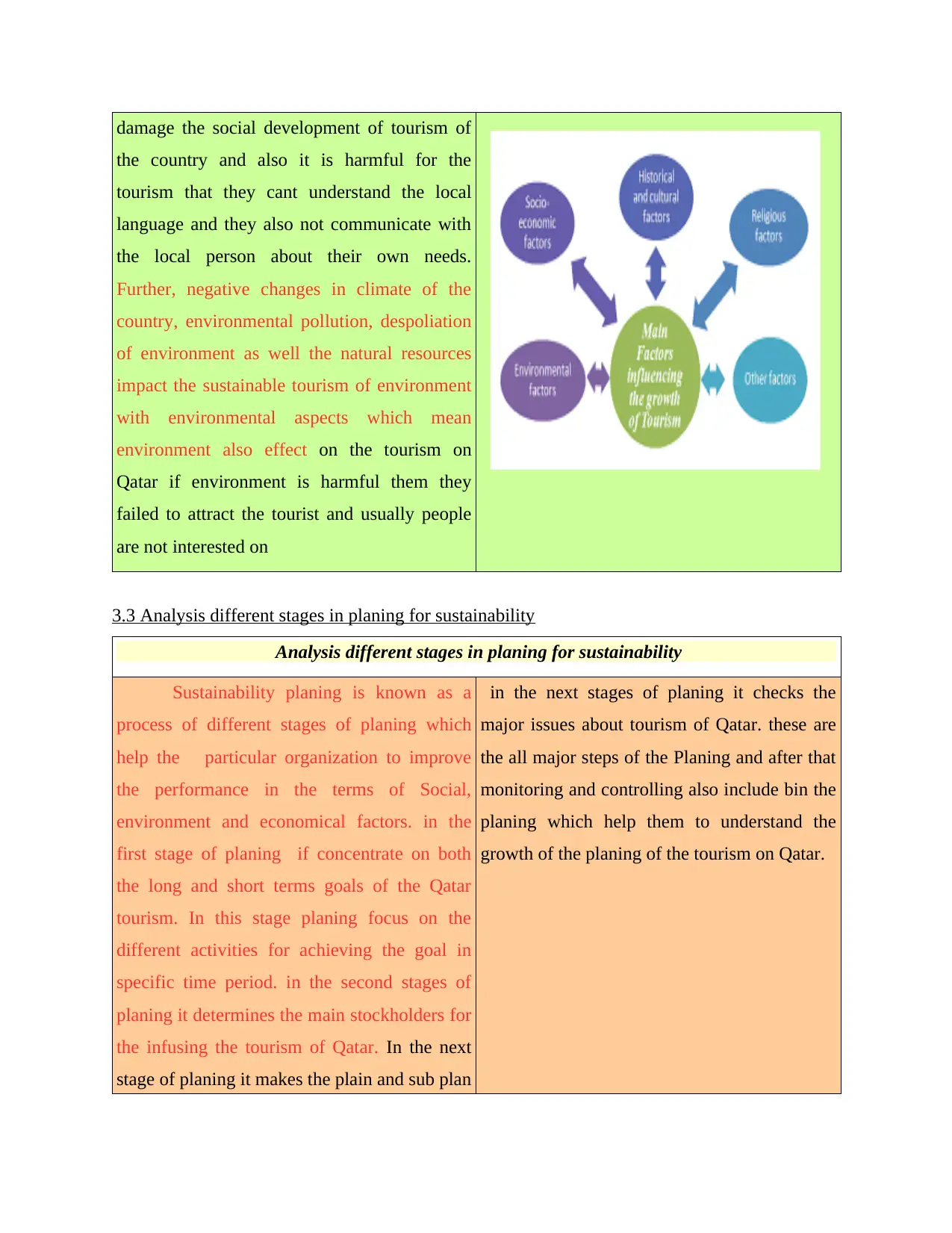
damage the social development of tourism of
the country and also it is harmful for the
tourism that they cant understand the local
language and they also not communicate with
the local person about their own needs.
Further, negative changes in climate of the
country, environmental pollution, despoliation
of environment as well the natural resources
impact the sustainable tourism of environment
with environmental aspects which mean
environment also effect on the tourism on
Qatar if environment is harmful them they
failed to attract the tourist and usually people
are not interested on
3.3 Analysis different stages in planing for sustainability
Analysis different stages in planing for sustainability
Sustainability planing is known as a
process of different stages of planing which
help the particular organization to improve
the performance in the terms of Social,
environment and economical factors. in the
first stage of planing if concentrate on both
the long and short terms goals of the Qatar
tourism. In this stage planing focus on the
different activities for achieving the goal in
specific time period. in the second stages of
planing it determines the main stockholders for
the infusing the tourism of Qatar. In the next
stage of planing it makes the plain and sub plan
in the next stages of planing it checks the
major issues about tourism of Qatar. these are
the all major steps of the Planing and after that
monitoring and controlling also include bin the
planing which help them to understand the
growth of the planing of the tourism on Qatar.
the country and also it is harmful for the
tourism that they cant understand the local
language and they also not communicate with
the local person about their own needs.
Further, negative changes in climate of the
country, environmental pollution, despoliation
of environment as well the natural resources
impact the sustainable tourism of environment
with environmental aspects which mean
environment also effect on the tourism on
Qatar if environment is harmful them they
failed to attract the tourist and usually people
are not interested on
3.3 Analysis different stages in planing for sustainability
Analysis different stages in planing for sustainability
Sustainability planing is known as a
process of different stages of planing which
help the particular organization to improve
the performance in the terms of Social,
environment and economical factors. in the
first stage of planing if concentrate on both
the long and short terms goals of the Qatar
tourism. In this stage planing focus on the
different activities for achieving the goal in
specific time period. in the second stages of
planing it determines the main stockholders for
the infusing the tourism of Qatar. In the next
stage of planing it makes the plain and sub plan
in the next stages of planing it checks the
major issues about tourism of Qatar. these are
the all major steps of the Planing and after that
monitoring and controlling also include bin the
planing which help them to understand the
growth of the planing of the tourism on Qatar.
Paraphrase This Document
Need a fresh take? Get an instant paraphrase of this document with our AI Paraphraser
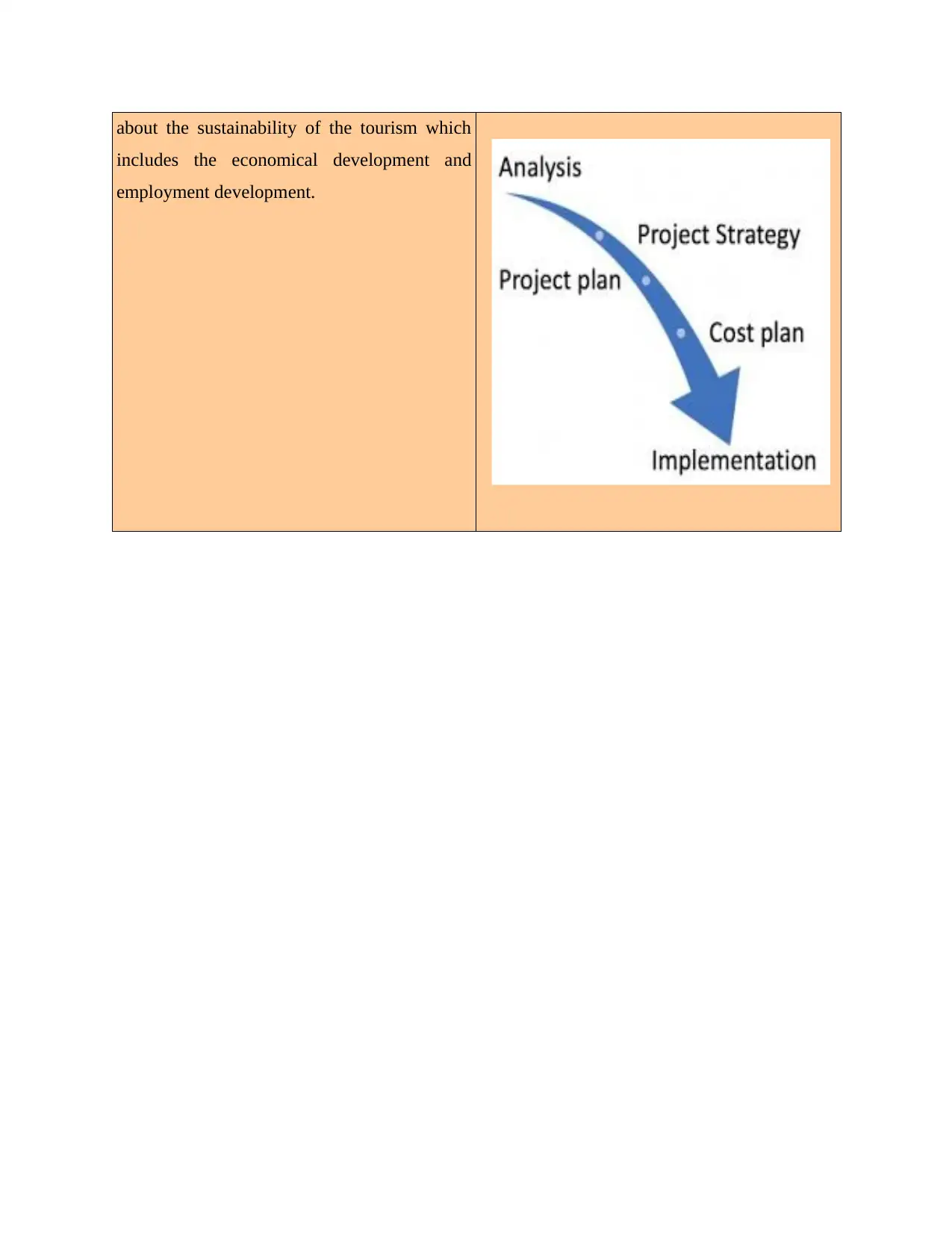
about the sustainability of the tourism which
includes the economical development and
employment development.
includes the economical development and
employment development.
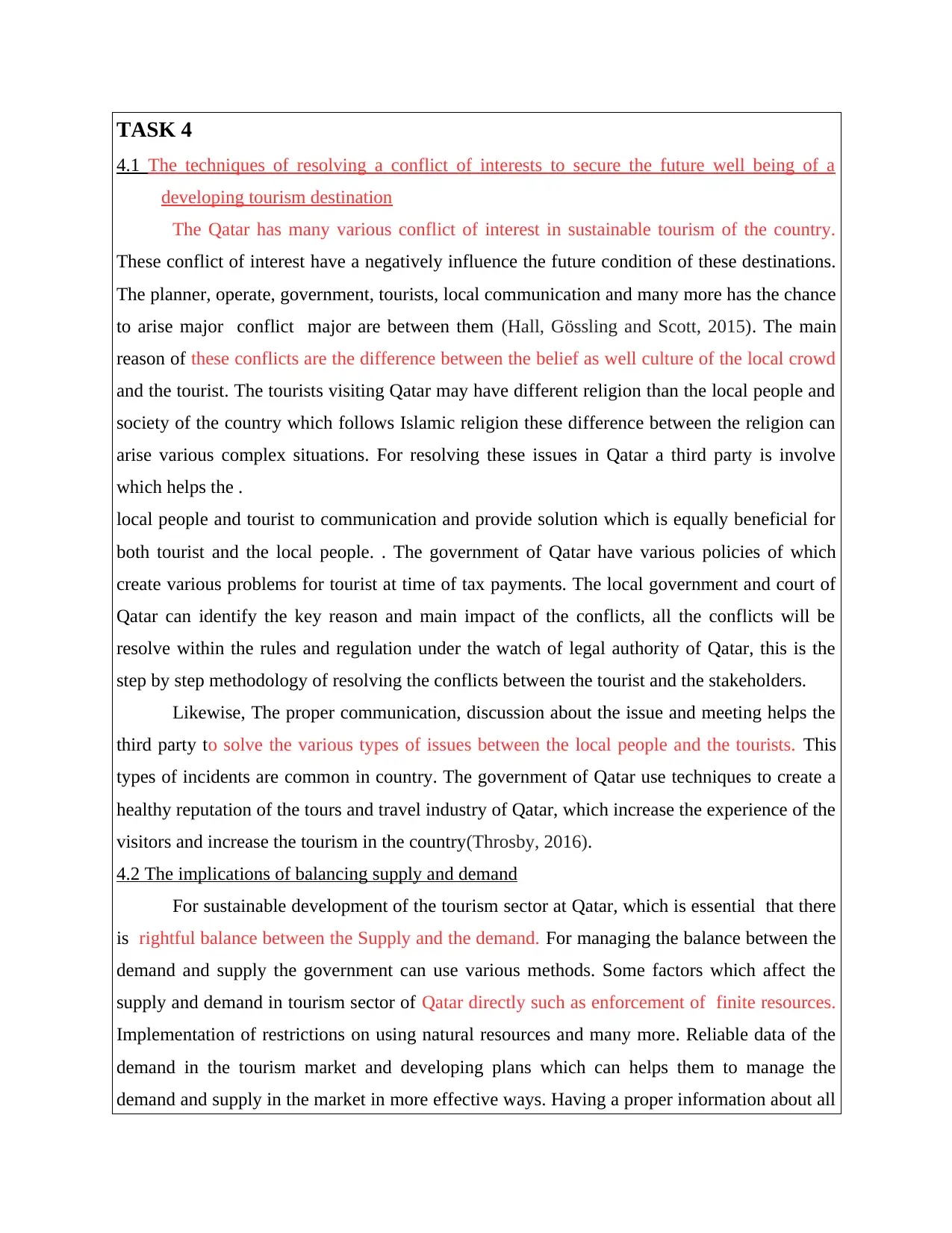
TASK 4
4.1 The techniques of resolving a conflict of interests to secure the future well being of a
developing tourism destination
The Qatar has many various conflict of interest in sustainable tourism of the country.
These conflict of interest have a negatively influence the future condition of these destinations.
The planner, operate, government, tourists, local communication and many more has the chance
to arise major conflict major are between them (Hall, Gössling and Scott, 2015). The main
reason of these conflicts are the difference between the belief as well culture of the local crowd
and the tourist. The tourists visiting Qatar may have different religion than the local people and
society of the country which follows Islamic religion these difference between the religion can
arise various complex situations. For resolving these issues in Qatar a third party is involve
which helps the .
local people and tourist to communication and provide solution which is equally beneficial for
both tourist and the local people. . The government of Qatar have various policies of which
create various problems for tourist at time of tax payments. The local government and court of
Qatar can identify the key reason and main impact of the conflicts, all the conflicts will be
resolve within the rules and regulation under the watch of legal authority of Qatar, this is the
step by step methodology of resolving the conflicts between the tourist and the stakeholders.
Likewise, The proper communication, discussion about the issue and meeting helps the
third party to solve the various types of issues between the local people and the tourists. This
types of incidents are common in country. The government of Qatar use techniques to create a
healthy reputation of the tours and travel industry of Qatar, which increase the experience of the
visitors and increase the tourism in the country(Throsby, 2016).
4.2 The implications of balancing supply and demand
For sustainable development of the tourism sector at Qatar, which is essential that there
is rightful balance between the Supply and the demand. For managing the balance between the
demand and supply the government can use various methods. Some factors which affect the
supply and demand in tourism sector of Qatar directly such as enforcement of finite resources.
Implementation of restrictions on using natural resources and many more. Reliable data of the
demand in the tourism market and developing plans which can helps them to manage the
demand and supply in the market in more effective ways. Having a proper information about all
4.1 The techniques of resolving a conflict of interests to secure the future well being of a
developing tourism destination
The Qatar has many various conflict of interest in sustainable tourism of the country.
These conflict of interest have a negatively influence the future condition of these destinations.
The planner, operate, government, tourists, local communication and many more has the chance
to arise major conflict major are between them (Hall, Gössling and Scott, 2015). The main
reason of these conflicts are the difference between the belief as well culture of the local crowd
and the tourist. The tourists visiting Qatar may have different religion than the local people and
society of the country which follows Islamic religion these difference between the religion can
arise various complex situations. For resolving these issues in Qatar a third party is involve
which helps the .
local people and tourist to communication and provide solution which is equally beneficial for
both tourist and the local people. . The government of Qatar have various policies of which
create various problems for tourist at time of tax payments. The local government and court of
Qatar can identify the key reason and main impact of the conflicts, all the conflicts will be
resolve within the rules and regulation under the watch of legal authority of Qatar, this is the
step by step methodology of resolving the conflicts between the tourist and the stakeholders.
Likewise, The proper communication, discussion about the issue and meeting helps the
third party to solve the various types of issues between the local people and the tourists. This
types of incidents are common in country. The government of Qatar use techniques to create a
healthy reputation of the tours and travel industry of Qatar, which increase the experience of the
visitors and increase the tourism in the country(Throsby, 2016).
4.2 The implications of balancing supply and demand
For sustainable development of the tourism sector at Qatar, which is essential that there
is rightful balance between the Supply and the demand. For managing the balance between the
demand and supply the government can use various methods. Some factors which affect the
supply and demand in tourism sector of Qatar directly such as enforcement of finite resources.
Implementation of restrictions on using natural resources and many more. Reliable data of the
demand in the tourism market and developing plans which can helps them to manage the
demand and supply in the market in more effective ways. Having a proper information about all
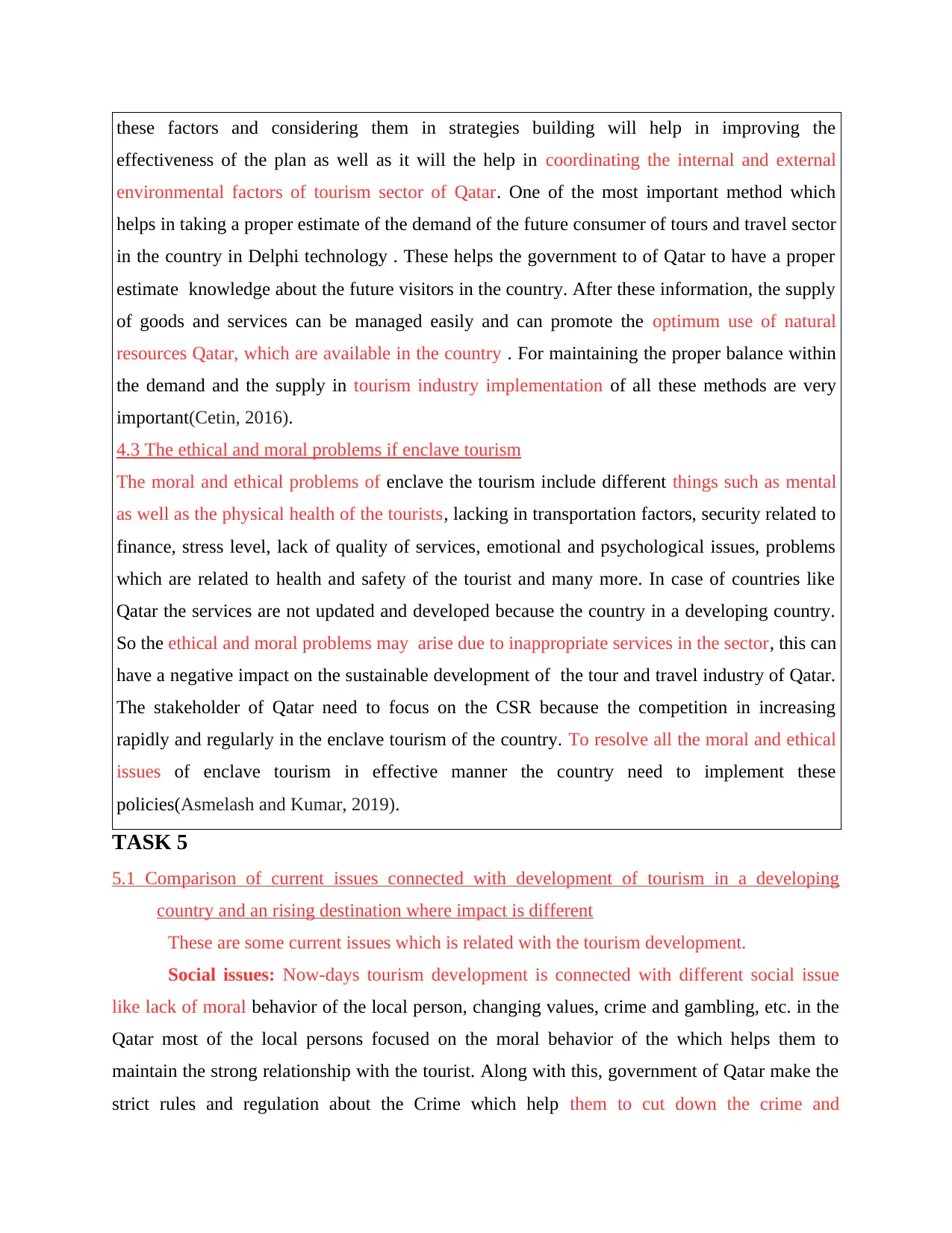
these factors and considering them in strategies building will help in improving the
effectiveness of the plan as well as it will the help in coordinating the internal and external
environmental factors of tourism sector of Qatar. One of the most important method which
helps in taking a proper estimate of the demand of the future consumer of tours and travel sector
in the country in Delphi technology . These helps the government to of Qatar to have a proper
estimate knowledge about the future visitors in the country. After these information, the supply
of goods and services can be managed easily and can promote the optimum use of natural
resources Qatar, which are available in the country . For maintaining the proper balance within
the demand and the supply in tourism industry implementation of all these methods are very
important(Cetin, 2016).
4.3 The ethical and moral problems if enclave tourism
The moral and ethical problems of enclave the tourism include different things such as mental
as well as the physical health of the tourists, lacking in transportation factors, security related to
finance, stress level, lack of quality of services, emotional and psychological issues, problems
which are related to health and safety of the tourist and many more. In case of countries like
Qatar the services are not updated and developed because the country in a developing country.
So the ethical and moral problems may arise due to inappropriate services in the sector, this can
have a negative impact on the sustainable development of the tour and travel industry of Qatar.
The stakeholder of Qatar need to focus on the CSR because the competition in increasing
rapidly and regularly in the enclave tourism of the country. To resolve all the moral and ethical
issues of enclave tourism in effective manner the country need to implement these
policies(Asmelash and Kumar, 2019).
TASK 5
5.1 Comparison of current issues connected with development of tourism in a developing
country and an rising destination where impact is different
These are some current issues which is related with the tourism development.
Social issues: Now-days tourism development is connected with different social issue
like lack of moral behavior of the local person, changing values, crime and gambling, etc. in the
Qatar most of the local persons focused on the moral behavior of the which helps them to
maintain the strong relationship with the tourist. Along with this, government of Qatar make the
strict rules and regulation about the Crime which help them to cut down the crime and
effectiveness of the plan as well as it will the help in coordinating the internal and external
environmental factors of tourism sector of Qatar. One of the most important method which
helps in taking a proper estimate of the demand of the future consumer of tours and travel sector
in the country in Delphi technology . These helps the government to of Qatar to have a proper
estimate knowledge about the future visitors in the country. After these information, the supply
of goods and services can be managed easily and can promote the optimum use of natural
resources Qatar, which are available in the country . For maintaining the proper balance within
the demand and the supply in tourism industry implementation of all these methods are very
important(Cetin, 2016).
4.3 The ethical and moral problems if enclave tourism
The moral and ethical problems of enclave the tourism include different things such as mental
as well as the physical health of the tourists, lacking in transportation factors, security related to
finance, stress level, lack of quality of services, emotional and psychological issues, problems
which are related to health and safety of the tourist and many more. In case of countries like
Qatar the services are not updated and developed because the country in a developing country.
So the ethical and moral problems may arise due to inappropriate services in the sector, this can
have a negative impact on the sustainable development of the tour and travel industry of Qatar.
The stakeholder of Qatar need to focus on the CSR because the competition in increasing
rapidly and regularly in the enclave tourism of the country. To resolve all the moral and ethical
issues of enclave tourism in effective manner the country need to implement these
policies(Asmelash and Kumar, 2019).
TASK 5
5.1 Comparison of current issues connected with development of tourism in a developing
country and an rising destination where impact is different
These are some current issues which is related with the tourism development.
Social issues: Now-days tourism development is connected with different social issue
like lack of moral behavior of the local person, changing values, crime and gambling, etc. in the
Qatar most of the local persons focused on the moral behavior of the which helps them to
maintain the strong relationship with the tourist. Along with this, government of Qatar make the
strict rules and regulation about the Crime which help them to cut down the crime and
Secure Best Marks with AI Grader
Need help grading? Try our AI Grader for instant feedback on your assignments.
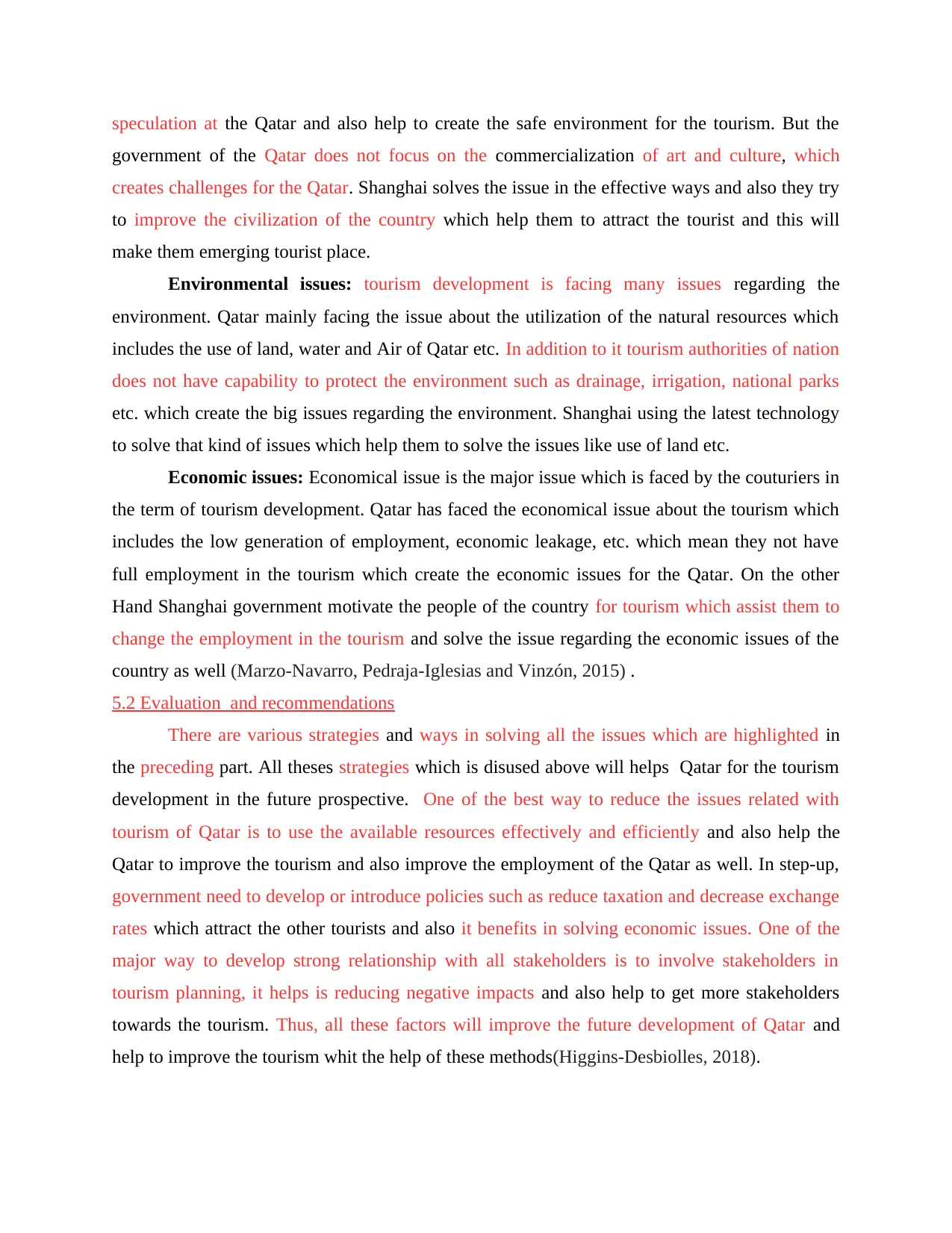
speculation at the Qatar and also help to create the safe environment for the tourism. But the
government of the Qatar does not focus on the commercialization of art and culture, which
creates challenges for the Qatar. Shanghai solves the issue in the effective ways and also they try
to improve the civilization of the country which help them to attract the tourist and this will
make them emerging tourist place.
Environmental issues: tourism development is facing many issues regarding the
environment. Qatar mainly facing the issue about the utilization of the natural resources which
includes the use of land, water and Air of Qatar etc. In addition to it tourism authorities of nation
does not have capability to protect the environment such as drainage, irrigation, national parks
etc. which create the big issues regarding the environment. Shanghai using the latest technology
to solve that kind of issues which help them to solve the issues like use of land etc.
Economic issues: Economical issue is the major issue which is faced by the couturiers in
the term of tourism development. Qatar has faced the economical issue about the tourism which
includes the low generation of employment, economic leakage, etc. which mean they not have
full employment in the tourism which create the economic issues for the Qatar. On the other
Hand Shanghai government motivate the people of the country for tourism which assist them to
change the employment in the tourism and solve the issue regarding the economic issues of the
country as well (Marzo-Navarro, Pedraja-Iglesias and Vinzón, 2015) .
5.2 Evaluation and recommendations
There are various strategies and ways in solving all the issues which are highlighted in
the preceding part. All theses strategies which is disused above will helps Qatar for the tourism
development in the future prospective. One of the best way to reduce the issues related with
tourism of Qatar is to use the available resources effectively and efficiently and also help the
Qatar to improve the tourism and also improve the employment of the Qatar as well. In step-up,
government need to develop or introduce policies such as reduce taxation and decrease exchange
rates which attract the other tourists and also it benefits in solving economic issues. One of the
major way to develop strong relationship with all stakeholders is to involve stakeholders in
tourism planning, it helps is reducing negative impacts and also help to get more stakeholders
towards the tourism. Thus, all these factors will improve the future development of Qatar and
help to improve the tourism whit the help of these methods(Higgins-Desbiolles, 2018).
government of the Qatar does not focus on the commercialization of art and culture, which
creates challenges for the Qatar. Shanghai solves the issue in the effective ways and also they try
to improve the civilization of the country which help them to attract the tourist and this will
make them emerging tourist place.
Environmental issues: tourism development is facing many issues regarding the
environment. Qatar mainly facing the issue about the utilization of the natural resources which
includes the use of land, water and Air of Qatar etc. In addition to it tourism authorities of nation
does not have capability to protect the environment such as drainage, irrigation, national parks
etc. which create the big issues regarding the environment. Shanghai using the latest technology
to solve that kind of issues which help them to solve the issues like use of land etc.
Economic issues: Economical issue is the major issue which is faced by the couturiers in
the term of tourism development. Qatar has faced the economical issue about the tourism which
includes the low generation of employment, economic leakage, etc. which mean they not have
full employment in the tourism which create the economic issues for the Qatar. On the other
Hand Shanghai government motivate the people of the country for tourism which assist them to
change the employment in the tourism and solve the issue regarding the economic issues of the
country as well (Marzo-Navarro, Pedraja-Iglesias and Vinzón, 2015) .
5.2 Evaluation and recommendations
There are various strategies and ways in solving all the issues which are highlighted in
the preceding part. All theses strategies which is disused above will helps Qatar for the tourism
development in the future prospective. One of the best way to reduce the issues related with
tourism of Qatar is to use the available resources effectively and efficiently and also help the
Qatar to improve the tourism and also improve the employment of the Qatar as well. In step-up,
government need to develop or introduce policies such as reduce taxation and decrease exchange
rates which attract the other tourists and also it benefits in solving economic issues. One of the
major way to develop strong relationship with all stakeholders is to involve stakeholders in
tourism planning, it helps is reducing negative impacts and also help to get more stakeholders
towards the tourism. Thus, all these factors will improve the future development of Qatar and
help to improve the tourism whit the help of these methods(Higgins-Desbiolles, 2018).
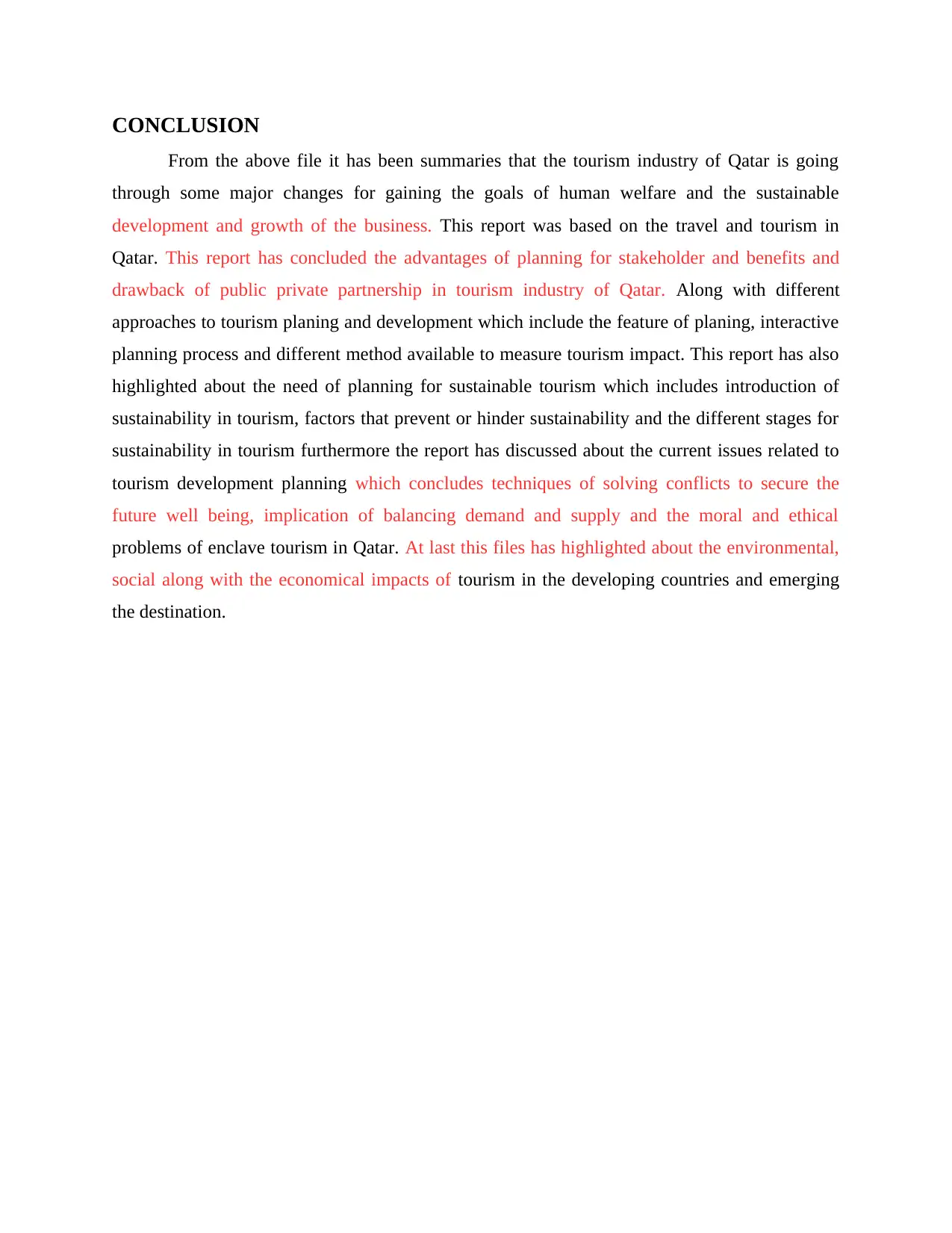
CONCLUSION
From the above file it has been summaries that the tourism industry of Qatar is going
through some major changes for gaining the goals of human welfare and the sustainable
development and growth of the business. This report was based on the travel and tourism in
Qatar. This report has concluded the advantages of planning for stakeholder and benefits and
drawback of public private partnership in tourism industry of Qatar. Along with different
approaches to tourism planing and development which include the feature of planing, interactive
planning process and different method available to measure tourism impact. This report has also
highlighted about the need of planning for sustainable tourism which includes introduction of
sustainability in tourism, factors that prevent or hinder sustainability and the different stages for
sustainability in tourism furthermore the report has discussed about the current issues related to
tourism development planning which concludes techniques of solving conflicts to secure the
future well being, implication of balancing demand and supply and the moral and ethical
problems of enclave tourism in Qatar. At last this files has highlighted about the environmental,
social along with the economical impacts of tourism in the developing countries and emerging
the destination.
From the above file it has been summaries that the tourism industry of Qatar is going
through some major changes for gaining the goals of human welfare and the sustainable
development and growth of the business. This report was based on the travel and tourism in
Qatar. This report has concluded the advantages of planning for stakeholder and benefits and
drawback of public private partnership in tourism industry of Qatar. Along with different
approaches to tourism planing and development which include the feature of planing, interactive
planning process and different method available to measure tourism impact. This report has also
highlighted about the need of planning for sustainable tourism which includes introduction of
sustainability in tourism, factors that prevent or hinder sustainability and the different stages for
sustainability in tourism furthermore the report has discussed about the current issues related to
tourism development planning which concludes techniques of solving conflicts to secure the
future well being, implication of balancing demand and supply and the moral and ethical
problems of enclave tourism in Qatar. At last this files has highlighted about the environmental,
social along with the economical impacts of tourism in the developing countries and emerging
the destination.
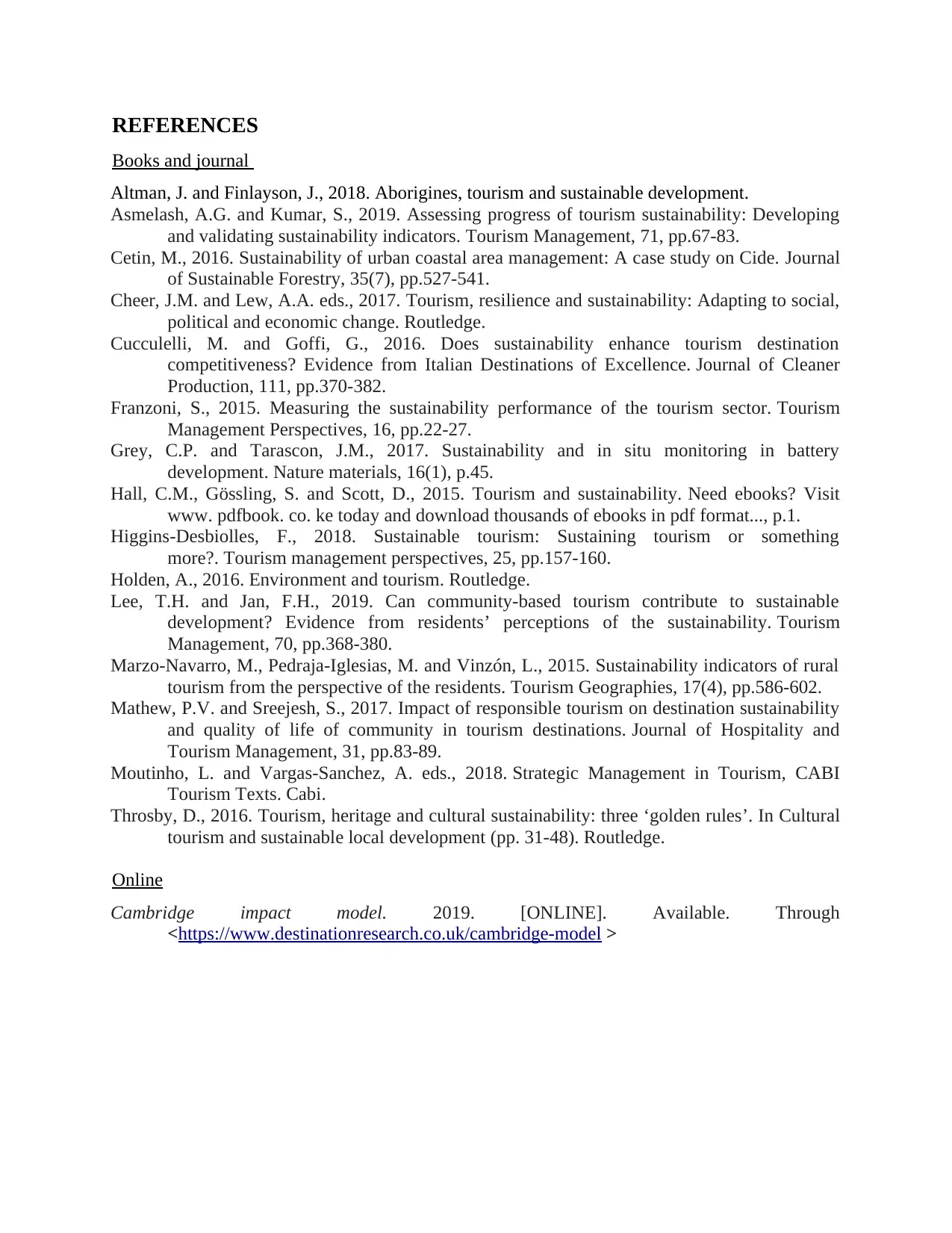
REFERENCES
Books and journal
Altman, J. and Finlayson, J., 2018. Aborigines, tourism and sustainable development.
Asmelash, A.G. and Kumar, S., 2019. Assessing progress of tourism sustainability: Developing
and validating sustainability indicators. Tourism Management, 71, pp.67-83.
Cetin, M., 2016. Sustainability of urban coastal area management: A case study on Cide. Journal
of Sustainable Forestry, 35(7), pp.527-541.
Cheer, J.M. and Lew, A.A. eds., 2017. Tourism, resilience and sustainability: Adapting to social,
political and economic change. Routledge.
Cucculelli, M. and Goffi, G., 2016. Does sustainability enhance tourism destination
competitiveness? Evidence from Italian Destinations of Excellence. Journal of Cleaner
Production, 111, pp.370-382.
Franzoni, S., 2015. Measuring the sustainability performance of the tourism sector. Tourism
Management Perspectives, 16, pp.22-27.
Grey, C.P. and Tarascon, J.M., 2017. Sustainability and in situ monitoring in battery
development. Nature materials, 16(1), p.45.
Hall, C.M., Gössling, S. and Scott, D., 2015. Tourism and sustainability. Need ebooks? Visit
www. pdfbook. co. ke today and download thousands of ebooks in pdf format..., p.1.
Higgins-Desbiolles, F., 2018. Sustainable tourism: Sustaining tourism or something
more?. Tourism management perspectives, 25, pp.157-160.
Holden, A., 2016. Environment and tourism. Routledge.
Lee, T.H. and Jan, F.H., 2019. Can community-based tourism contribute to sustainable
development? Evidence from residents’ perceptions of the sustainability. Tourism
Management, 70, pp.368-380.
Marzo-Navarro, M., Pedraja-Iglesias, M. and Vinzón, L., 2015. Sustainability indicators of rural
tourism from the perspective of the residents. Tourism Geographies, 17(4), pp.586-602.
Mathew, P.V. and Sreejesh, S., 2017. Impact of responsible tourism on destination sustainability
and quality of life of community in tourism destinations. Journal of Hospitality and
Tourism Management, 31, pp.83-89.
Moutinho, L. and Vargas-Sanchez, A. eds., 2018. Strategic Management in Tourism, CABI
Tourism Texts. Cabi.
Throsby, D., 2016. Tourism, heritage and cultural sustainability: three ‘golden rules’. In Cultural
tourism and sustainable local development (pp. 31-48). Routledge.
Online
Cambridge impact model. 2019. [ONLINE]. Available. Through
<https://www.destinationresearch.co.uk/cambridge-model >
Books and journal
Altman, J. and Finlayson, J., 2018. Aborigines, tourism and sustainable development.
Asmelash, A.G. and Kumar, S., 2019. Assessing progress of tourism sustainability: Developing
and validating sustainability indicators. Tourism Management, 71, pp.67-83.
Cetin, M., 2016. Sustainability of urban coastal area management: A case study on Cide. Journal
of Sustainable Forestry, 35(7), pp.527-541.
Cheer, J.M. and Lew, A.A. eds., 2017. Tourism, resilience and sustainability: Adapting to social,
political and economic change. Routledge.
Cucculelli, M. and Goffi, G., 2016. Does sustainability enhance tourism destination
competitiveness? Evidence from Italian Destinations of Excellence. Journal of Cleaner
Production, 111, pp.370-382.
Franzoni, S., 2015. Measuring the sustainability performance of the tourism sector. Tourism
Management Perspectives, 16, pp.22-27.
Grey, C.P. and Tarascon, J.M., 2017. Sustainability and in situ monitoring in battery
development. Nature materials, 16(1), p.45.
Hall, C.M., Gössling, S. and Scott, D., 2015. Tourism and sustainability. Need ebooks? Visit
www. pdfbook. co. ke today and download thousands of ebooks in pdf format..., p.1.
Higgins-Desbiolles, F., 2018. Sustainable tourism: Sustaining tourism or something
more?. Tourism management perspectives, 25, pp.157-160.
Holden, A., 2016. Environment and tourism. Routledge.
Lee, T.H. and Jan, F.H., 2019. Can community-based tourism contribute to sustainable
development? Evidence from residents’ perceptions of the sustainability. Tourism
Management, 70, pp.368-380.
Marzo-Navarro, M., Pedraja-Iglesias, M. and Vinzón, L., 2015. Sustainability indicators of rural
tourism from the perspective of the residents. Tourism Geographies, 17(4), pp.586-602.
Mathew, P.V. and Sreejesh, S., 2017. Impact of responsible tourism on destination sustainability
and quality of life of community in tourism destinations. Journal of Hospitality and
Tourism Management, 31, pp.83-89.
Moutinho, L. and Vargas-Sanchez, A. eds., 2018. Strategic Management in Tourism, CABI
Tourism Texts. Cabi.
Throsby, D., 2016. Tourism, heritage and cultural sustainability: three ‘golden rules’. In Cultural
tourism and sustainable local development (pp. 31-48). Routledge.
Online
Cambridge impact model. 2019. [ONLINE]. Available. Through
<https://www.destinationresearch.co.uk/cambridge-model >
1 out of 13
Related Documents
Your All-in-One AI-Powered Toolkit for Academic Success.
+13062052269
info@desklib.com
Available 24*7 on WhatsApp / Email
![[object Object]](/_next/static/media/star-bottom.7253800d.svg)
Unlock your academic potential
© 2024 | Zucol Services PVT LTD | All rights reserved.
![[Sustainable Tourism Development and Environmental Conservation]](/_next/image/?url=https%3A%2F%2Fdesklib.com%2Fmedia%2Fimages%2Fna%2F9431cb89f401456684161ad0e4b5b8e0.jpg&w=256&q=75)




